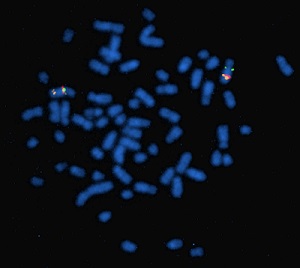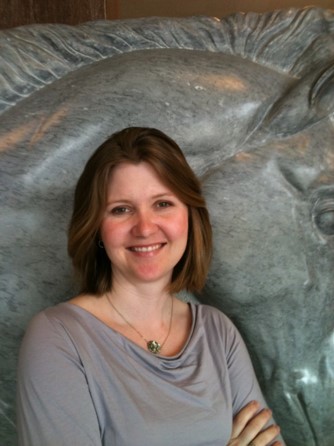 The horse genome contains all the information required to direct the growth and function of a foal, from conception to death. This enormous “text” is organized into chromosomes, much like the volumes of an encyclopedia. The domesticated horse possesses 32 unique chromosomes, and most cells carry two copies of each chromosome for a total of 64. Gametes of course are the exception, carrying just one of each of the chromosome pairs to the future offspring. This article will discuss information about genotype vs. phenotype, genetic testing, and recent genetic studies performed on stallions.
The horse genome contains all the information required to direct the growth and function of a foal, from conception to death. This enormous “text” is organized into chromosomes, much like the volumes of an encyclopedia. The domesticated horse possesses 32 unique chromosomes, and most cells carry two copies of each chromosome for a total of 64. Gametes of course are the exception, carrying just one of each of the chromosome pairs to the future offspring. This article will discuss information about genotype vs. phenotype, genetic testing, and recent genetic studies performed on stallions.
The X and the Y
Just like humans, horses use two mismatched sex chromosomes, the X and the Y to determine sex: XX for females, XY for males. In every animal the two copies of each chromosome are not identical, creating “alleles” that control a diverse set of traits like temperament, height or fertility. Different interactions and combinations of the “alleles” lead to simple inheritance patterns like “dominant” and “recessive” that are frequently used to describe genetic traits like coat color.
Genotype vs. Phenotype
Geneticists call the information written in the DNA sequence a “genotype”, and the physical trait you can measure on the horse a “phenotype”. Genotypes, interactions among genes, and factors from the environment can significantly alter most phenotypes. As a result, an exceptional horse may have only average genes, or an average horse may have exceptional genes but suffered in a subpar developmental environment. For example, a colt may have the genetic potential for superb fertility, but an intervention like gelding can completely negate his fertility. Only the genes are passed from sire to offspring, not the alterations due to the environment. Therefore, it makes sense to examine the genes of a potential stallion with at least as much scrutiny as one might use to evaluate his conformation or performance record.
Genetic Testing
 Breeders today have an unprecedented number of genetic tests to select from. Recent success in mapping the genetic variants responsible for important traits is a direct result of the completion of the equine genome sequence in 2009. With novel tools developed from the genome sequence we now have the power to determine the genetic component of complex conditions like disease resistance or athletic performance. To date there are approximately 132 known genetic markers for 61 unique traits in the horse. However, getting these valuable tests in to the hands of breeders has been a slow process.
Breeders today have an unprecedented number of genetic tests to select from. Recent success in mapping the genetic variants responsible for important traits is a direct result of the completion of the equine genome sequence in 2009. With novel tools developed from the genome sequence we now have the power to determine the genetic component of complex conditions like disease resistance or athletic performance. To date there are approximately 132 known genetic markers for 61 unique traits in the horse. However, getting these valuable tests in to the hands of breeders has been a slow process.
Unlike genetic testing in human medicine, DNA based diagnostics in the horse do not require a prescription from a health care professional. While this lack of regulation allows widespread access to testing services, it also means there is little motivation in the industry to regulate the quality of services offered by commercial animal genetic testing companies. One bad experience with a less than reputable company may discourage horse owners from investing in genetic testing in the future.
Likewise, although the costs of traditional individual genetic tests have remained low, around $20 a test, when this cost is multiplied times the dozens or hundreds of markers required to predict exciting new complex traits like racing performance the costs to horse owners rise steeply, especially if they have a large herd.
Luckily, new breakthroughs in the chemistry and equipment used to determine genotypes is lowering the cost of these tests quickly and large multi-marker panels at very affordable prices are now entering the market. Emerging new companies will increase competition in the market, driving the quality of customer service up as horse owners have the power to take their business elsewhere.
Recent Genetic Studies
Recent genetic studies have described traits of particular interest to the owners of promising young stallions.
- Research coordinated by Dr. Ottmar Distl, University of Veterinary Medicine in Hannover, describes new markers in a single gene called PLCz1 contributing to the pregnancy rate per estrus cycle in Hanoverian Stallions [1].
- Exciting new work on a gene named FKBP6 by the Raudsepp lab at Texas A&M revealed that a genetic change created a high risk of developing Impaired Acrosome Reaction, a condition that can render a stallion infertile [2].
- Later work illustrated new alleles at this same gene contributing to other parameters for fertility, suggesting that the FKBP6 gene is of particular importance to reproductive fitness in the stallion [3].
Recent, and on-going research focuses on developing predictive tests for traits of performance, health, and of course, fertility. The technology allowing mare owners to “shop by genotype” for their next stallion is already here, it won’t be long before the industry “takes the reins” and fully applies these new tools to the benefit of the horse.
_____________________________________________________________________________________________
1. Schrimpf R, Dierks C, Martinsson G, Sieme H, Distl O. Genome-wide association study identifies phospholipase C zeta 1 (PLCz1) as a stallion fertility locus in Hanoverian warmblood horses. PLoS One. 2014;9(10):e109675. doi: 10.1371/journal.pone.0109675. PubMed PMID: 25354211; PubMed Central PMCID: PMCPMC4212906.
2. Raudsepp T, McCue ME, Das PJ, Dobson L, Vishnoi M, Fritz KL, et al. Genome-wide association study implicates testis-sperm specific FKBP6 as a susceptibility locus for impaired acrosome reaction in stallions. PLoS Genet. 2012;8(12):e1003139. doi: 10.1371/journal.pgen.1003139. PubMed PMID: 23284302; PubMed Central PMCID: PMCPMC3527208.
3. Schrimpf R, Metzger J, Martinsson G, Sieme H, Distl O. Implication of FKBP6 for male fertility in horses. Reprod Domest Anim. 2015;50(2):195-9. doi: 10.1111/rda.12467. PubMed PMID: 25495881.
4. Aurich JE, Kühne A, Hoppe H, Aurich C. Seminal plasma affects membrane integrity and motility of equine spermatozoa after cryopreservation. Theriogenology. 1996;46(5):791-7. PubMed PMID: 16727943
Click to edit your new post...





